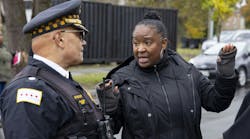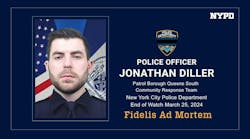Sept. 09--The scene plays out countless times each day for officers patrolling California's roadways.
Amid the chaos of highway traffic, they approach a stopped vehicle. They watch for the driver's hands, try to make eye contact, look for anything amiss. They must then reach a crucial judgment: Is there a threat here?
While it might be all part of the "routine," the shooting death of California Highway Patrol Officer Kenyon Youngstrom last week showed that there is nothing routine about a traffic stop.
CHP colleagues mourning Youngstrom's death also quietly acknowledge that any one of them could have been in his place. All of them do what Youngstrom did that morning -- walk toward a vehicle with little idea of the possible dangers.
"You hear about when the shooting happens," said Elon Steers, a CHP officer and spokesman who was close friends with Youngstrom. "What nobody knows is the hundreds of thousands of incidents where it almost happened."
The risks and sense of uncertainty are similar for members of any police force, but the CHP is particularly aware of the risks. The agency safeguards 106,000 miles of the state's roads, and CHP officials estimate their officers pull over nearly 4 million motorists statewide each year, issuing more than 1 million citations.
All of those stops, for violations large and small, share one disconcerting factor: CHP officers often have little information about who they've just pulled over on an
interstate freeway system that handles millions of vehicles.
"It could be as simple as someone who forgot to put the registration tab on their car," said Officer DJ Sarabia, an 18-year CHP veteran based out of San Jose. "It could also be someone who just robbed a bank we don't know about."
But is it practical, or even possible, to be hyperattentive on every road stop?
"It's especially tough when you're a patrol officer who is pulling people over all day," said Peter Keane, a former San Francisco police commissioner who teaches law at Golden Gate University. "You can't be on an adrenaline high for every stop or you'd have a heart attack by the end of the day. So maybe there's a chance to miss warning signs or, like in this case, maybe there are no signs to see."
The Youngstrom shooting is a tragic example of how even the seemingly most random and mundane stop can suddenly, horribly, turn violent. The Contra Costa County-based officer had stopped his patrol car to tend to a dead deer on the roadside Tuesday morning in the southbound lanes of Interstate 680 in Alamo, just south of Walnut Creek. His partner radioed to tell him that he was approaching the same area to pull over a Jeep Wrangler for having an obscured license plate.
The Jeep stopped a few feet behind Youngstrom's parked cruiser. Youngstrom walked up to the driver's side of the Jeep and briefly spoke with driver Christopher Boone Lacy, who then pulled out a handgun and shot the officer in the head.
Youngstrom, 37, a married father of four from Cordelia and a seven-year CHP veteran, was taken off life support and pronounced dead Wednesday after it was arranged for his organs and body tissue to be donated.
Lacy, 36, of the rural Northern California town of Corning, was mortally wounded by the other CHP officer after Youngstrom was shot. The investigation is continuing and Lacy's motive may never be understood.
But the incident underscores what everyone with ties to law-enforcement already knew: Traffic stops are unpredictable, harrowing and in rare cases, deadly.
The National Law Enforcement Officers Memorial Fund says there have been 72 traffic-related fatalities of California law-enforcement officers during the past decade, though it's unclear how many occurred during stops. During that same period, CHP officers were shot at during five stops, two of them fatally. Last year alone, 98 officers were assaulted and injured.
Anecdotally, officers described traffic stops as a paradoxical mix of tedious repetition and an acute sense of vulnerability.
"I promise you that every cop has at least one moment in his career where it's almost become PTSD for them and they have flashbacks to walking up to a car and wondering what's waiting for them," said attorney Jim Hammer, a former San Francisco prosecutor who was a reserve police officer for five years. "A policeman never knows if this is the 1-in-10,000 person who is dangerous and wants to do them harm."
Sarabia, the CHP officer based out of San Jose, added that sense of the unknown can be the toughest part of any stop.
He recalled once when, as a new officer training with his supervisor, they pulled over a vehicle and the driver immediately got out. The other officer intuitively warned Sarabia to keep a lookout for a gun -- something that the younger officer was amazed to find under the seat.
You just, Sarabia added, never know.
"Some of it is instinct, when you know there's something not right," he said. "You call for another unit if you're not feeling secure. If the hairs are up on the back of your neck, there's a reason why."
That awareness is in the mind of every CHP officer. Steers said, as close friends, he and Youngstrom often talked about safety on the job.
"We discussed these things frequently," Steers said, pausing to compose himself. "How do we minimize or reduce danger?"
Complicating the dangers, Keane said, is the relatively recent proliferation of firearms.
"Two decades ago, the idea that this regular type of guy would have a loaded gun in his car would be very remote," said Keane, the law professor. "Now it's a case of Russian roulette for officers every time they pull over a car."
Investigators discovered a semi-automatic handgun, two loaded magazines of ammunition and a knife in Lacy's Jeep. Without a gun involved, Keane added, there's a chance the stop might have ended with Lacy in the back of the patrol car after a shouting match or scuffle.
"Instead we have this escalation that leads to a terrible tragedy and the loss of a good man, a husband and a father," he added. "There's a reason why the main proponent of sane gun laws always is the police. They see the craziness and carnage that comes out of these situations."
Dennis Kenney, a professor at New York's John Jay College of Criminal Justice who specializes in police issues, said traffic stops create moments where officers must navigate a fine line between wariness and calm presence.
"If an officer walks toward the car with one hand on his weapon, the driver might be offended and think: 'Why are they treating me like a criminal,' " Kenney said. "At the same time, that driver might have just robbed a bank. Officers are in a tight spot because every once in a great while, you come upon a terrible situation if you don't have your guard up."
Not knowing when such a situation will suddenly erupt becomes just part of the routine.
"Any time you insert yourself in harm's way, finding suspicious situations and confronting them, you accept the risk," Kenney said. "You can train to minimize that risk, but some days bad things are going to happen."
Contact Mark Emmons at [email protected]. Contact Robert Salonga at 408-920-5002.
TO HELP
Two Bay Area banks have set up accounts to benefit the family of Officer Kenyon Youngstrom:
At any Wells Fargo Bank branch, tellers will accept donations for the Kenyon Marc Youngstrom Children's Benefit Memorial fund.
At any Mechanics Bank branch, mention the officer's name to the teller and direct that funds be contributed to the trust account in his name. Checks payable to "For Benefit of Officer Kenyon Youngstrom" can also be mailed to Mechanics Bank, 1350 North Main St., Walnut Creek, Calif. 94596. Wire transfers can be sent to routing number 121102036 and addressed "For Officer Kenyon Youngstrom."
Copyright 2012 - San Jose Mercury News


